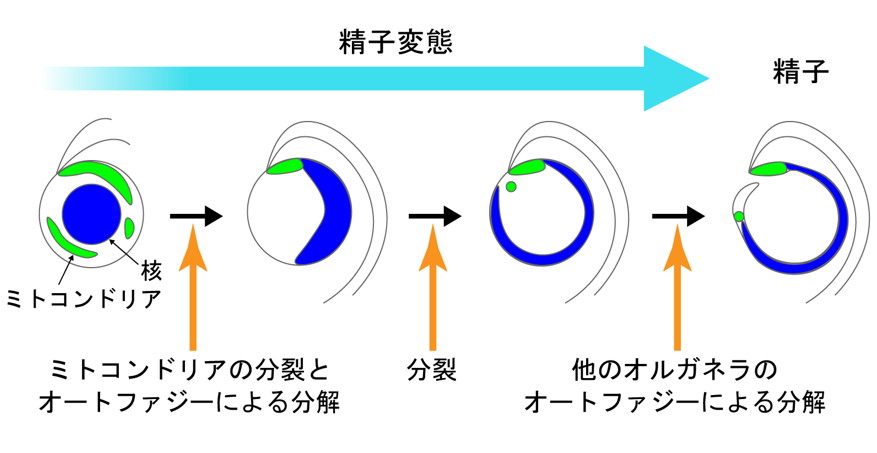DATE2022.06.15 #Press Releases
Role of Autophagy in Spermatogenesis in Plants
Disclaimer: machine translated by DeepL which may contain errors.
The Institute for Basic Biology
Graduate School of Science, The University of Tokyo
Gunma University
Summary
Many people may imagine plant fertilization as sperm cells being transported from pollen to eggs via pollen tubes that extend from the pollen. However, some plants, such as mosses and ferns, produce sperm that swim to the egg. Spermatozoa of mosses have a structure in which two flagella grow from the head of an elongated spiral-shaped cell body, and these flagella are moved to generate propulsion. During the process of sperm production, major organelle (cell organelle) changes occur. Among them, the number and shape of mitochondria, which are the site of energy production and various metabolism, are known to change drastically during the sperm metamorphosis process, in which sperm cells are transformed into spermatozoa. Moss plants normally have a large number of mitochondria in their cells, but the number of mitochondria in a complete sperm is fixed at two, one at the head and one at the tail of the sperm. However, it was not known how this characteristic arrangement of mitochondria in sperm is formed.
A research group consisting of Dr. Takuya Hozuki (currently JSPS Research Fellow at the Institute for Cellular Biology, Gunma University), Dr. Naoki Minamino, Project Assistant Professor, and Professor Takashi Ueda at the Institute for Cell Biology and Cell Bioregulation, National Institute for Basic Biology, together with Professor Yuichi Tsukatani at the Graduate School of Science, The University of Tokyo and Professor Miyuki Sato at the Institute for Bioregulation, Gunma University, has been studying spermatozoa in mosses, including the spermatozoan By studying the process of sperm metamorphosis in Zeni mosses, they discovered that mitochondria undergo mitosis and subsequent degradation by autophagy (autophagy) during the early stage of sperm metamorphosis, and once their number is reduced to one, they then divide to two. The autophagy was also involved in the degradation of organelles and cytoplasm other than mitochondria, but mitochondria are not degraded together with other organelles, but are degraded at different times and under different controls. During the sperm metamorphosis process in mammals and other animals, unwanted organelles and cytoplasm are removed by incorporation and degradation by neighboring cells. However, plant cells surrounded by cell walls cannot undergo sperm metamorphosis in the same way as animals. This study reveals a unique mechanism of organelle reorganization in sperm metamorphosis in mosses. The research results were published in the U.S. scientific journal Cell Reports on June 15, 2022, at midnight Japan time.

Figure: Schematic diagram of mitochondrial changes during sperm metamorphosis in moss plants revealed in this study
For more information, please visit the website of the Institute for Basic Biology.


